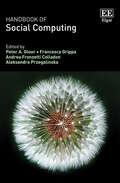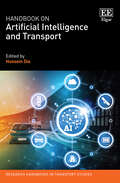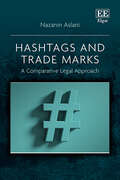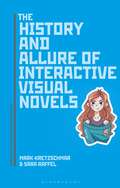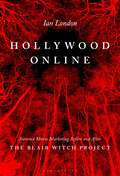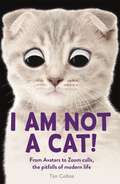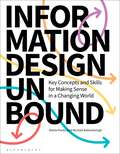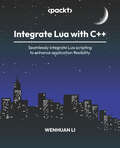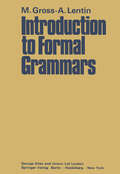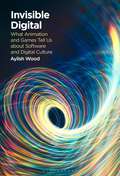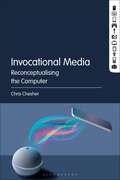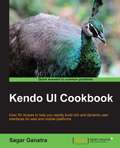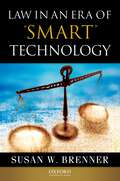- Table View
- List View
Handbook of Social Computing
Responding to the increasingly blurred boundaries between humans and technology, this innovative Handbook reveals the intricate patterns of interaction between individuals, machines, organizations and beyond, even including AI-extended human interaction with animals and plants. Using cutting-edge data and analysis, expert contributors provide new insight into the rapidly growing digitalization of society.Chapters span disciplinary boundaries, covering both computer science and AI, as well as sociology and psychology, to encompass all aspects of social computing as an emerging field. They also examine the complexity of social networks and algorithmic decision-making whilst drawing on case studies from diverse industries and exploring important issues, such as the ethical implications of AI, data privacy regulation, and safe data sharing. Ultimately, this Handbook illustrates the diverse ways in which digital technologies can be used to analyze social behavior, recognise individual and group interaction patterns, and improve daily life.Providing a comprehensive overview of the latest developments in social computing, this Handbook will be an essential read for students and scholars of human dynamics, social network analysis, and sociology. It will also be an invaluable guide for professionals seeking a deeper understanding of how technology can be used to analyze social dynamics.
Handbook on Artificial Intelligence and Transport (Research Handbooks in Transport Studies series)
With AI advancements eliciting imminent changes to our transport systems, this enlightening Handbook presents essential research on this evolution of the transportation sector. It focuses on not only urban planning, but relevant themes in law and ethics to form a unified resource on the practicality of AI use.The Handbook on Artificial Intelligence and Transport provides a full investigation of the most recent AI transport developments, authored by an international collective of renowned contributors. Chapters examine several often challenging topics such as autonomous driving and cyber security ethics. They conclude that AI technology is likely to offer resolutions to persistent transport issues that have been almost impossible to solve using conventional approaches.This timely Handbook will be an important resource for students of transport planning and engineering, innovation and regional law. It will also benefit practitioners within the sectors of urban planning and engineering seeking updated evidence on the role of AI in transport improvement.
Hands-On Application Development with PyCharm: Build applications like a pro with the ultimate python development tool
by Bruce M. II Quan NguyenUnleash the power of PyCharm to craft business, scientific, and web applications in Python with this definitive guideKey FeaturesLearn basic to advanced PyCharm concepts to improve developer efficiency on your Python projectsLearn with practical examples that focus on efficient application developmentExplore features such as code automation, graphical debugging, and remote developmentPurchase of the print or Kindle book includes a free PDF eBookBook DescriptionIn the quest to develop robust, professional-grade software with Python and meet tight deadlines, it’s crucial to have the best tools at your disposal. In this second edition of Hands-on Application Development with PyCharm, you’ll learn tips and tricks to work at a speed and proficiency previously reserved only for elite developers. To achieve that, you’ll be introduced to PyCharm, the premiere professional integrated development environment for Python programmers among the myriad of IDEs available. Regardless of how Python is utilized, whether for general automation scripting, utility creation, web applications, data analytics, machine learning, or business applications, PyCharm offers tooling that simplifies complex tasks and streamlines common ones. In this book, you'll find everything you need to harness PyCharm's full potential and make the most of Pycharm's productivity shortcuts. The book comprehensively covers topics ranging from installation and customization to web development, database management, and data analysis pipeline development helping you become proficient in Python application development in diverse domains. By the end of this book, you’ll have discovered the remarkable capabilities of PyCharm and how you can achieve a new level of capability and productivity.What you will learnExplore basic and advanced PyCharm featuresSet up, configure, and customize your Python projects in PyCharmDevelop web applications with Flask, Django, FastAPI, and PyramidDiscover PyCharm's capabilities for database management and data visualizationExplore code automation, debugging, and remote development in PyCharmPerform data science tasks using Jupyter notebooks, NumPy, and pandasWho this book is forThis book is for Python practitioners and learners looking to boost their productivity and proficiency by harnessing the features and capabilities of PyCharm, all while gaining insights into best practices for modern application development. Basic knowledge of Python is required, making the book accessible to both newcomers and experienced Python developers.
Hands-On Design Patterns with C++: Solve common C++ problems with modern design patterns and build robust applications
by Fedor G. PikusA comprehensive guide with extensive coverage of concepts such as OOP, functional programming, generic programming, concurrency, and STL along with the latest features of C++ Purchase of the print or Kindle book includes a free PDF eBookKey FeaturesDelve into the core patterns and components of C++ to master application designLearn tricks, techniques, and best practices to solve common design and architectural challengesUnderstand the limitation imposed by C++ and how to solve them using design patternsBook DescriptionC++ is a general-purpose programming language designed for efficiency, performance, and flexibility. Design patterns are commonly accepted solutions to well-recognized design problems. In essence, they are a library of reusable components, only for software architecture, and not for a concrete implementation. This book helps you focus on the design patterns that naturally adapt to your needs, and on the patterns that uniquely benefit from the features of C++. Armed with the knowledge of these patterns, you’ll spend less time searching for solutions to common problems and tackle challenges with the solutions developed from experience. You’ll also explore that design patterns are a concise and efficient way to communicate, as patterns are a familiar and recognizable solution to a specific problem and can convey a considerable amount of information with a single line of code. By the end of this book, you’ll have a deep understanding of how to use design patterns to write maintainable, robust, and reusable software. What you will learnRecognize the most common design patterns used in C++Understand how to use C++ generic programming to solve common design problemsExplore the most powerful C++ idioms, their strengths, and their drawbacksRediscover how to use popular C++ idioms with generic programmingDiscover new patterns and idioms made possible by language features of C++17 and C++20Understand the impact of design patterns on the program’s performanceWho this book is forThis book is for experienced C++ developers and programmers who wish to learn about software design patterns and principles and apply them to create robust, reusable, and easily maintainable programs and software systems.
A Hands-On Introduction to Data Science
by null Chirag ShahThis book introduces the field of data science in a practical and accessible manner, using a hands-on approach that assumes no prior knowledge of the subject. The foundational ideas and techniques of data science are provided independently from technology, allowing students to easily develop a firm understanding of the subject without a strong technical background, as well as being presented with material that will have continual relevance even after tools and technologies change. Using popular data science tools such as Python and R, the book offers many examples of real-life applications, with practice ranging from small to big data. A suite of online material for both instructors and students provides a strong supplement to the book, including datasets, chapter slides, solutions, sample exams and curriculum suggestions. This entry-level textbook is ideally suited to readers from a range of disciplines wishing to build a practical, working knowledge of data science.
A Hands-On Introduction to Machine Learning
by null Chirag ShahPacked with real-world examples, industry insights and practical activities, this textbook is designed to teach machine learning in a way that is easy to understand and apply. It assumes only a basic knowledge of technology, making it an ideal resource for students and professionals, including those who are new to computer science. All the necessary topics are covered, including supervised and unsupervised learning, neural networks, reinforcement learning, cloud-based services, and the ethical issues still posing problems within the industry. While Python is used as the primary language, many exercises will also have the solutions provided in R for greater versatility. A suite of online resources is available to support teaching across a range of different courses, including example syllabi, a solutions manual, and lecture slides. Datasets and code are also available online for students, giving them everything they need to practice the examples and problems in the book.
Hands-On Web Scraping with Python: Extract quality data from the web using effective Python techniques
by Anish ChapagainWork through practical examples to unlock the full potential of web scraping with Python and gain valuable insights from high-quality dataKey FeaturesBuild an initial portfolio of web scraping projects with detailed explanationsGrasp Python programming fundamentals related to web scraping and data extractionAcquire skills to code web scrapers, store data in desired formats, and employ the data professionallyPurchase of the print or Kindle book includes a free PDF eBookBook DescriptionWeb scraping is a powerful tool for extracting data from the web, but it can be daunting for those without a technical background. Designed for novices, this book will help you grasp the fundamentals of web scraping and Python programming, even if you have no prior experience. Adopting a practical, hands-on approach, this updated edition of Hands-On Web Scraping with Python uses real-world examples and exercises to explain key concepts. Starting with an introduction to web scraping fundamentals and Python programming, you’ll cover a range of scraping techniques, including requests, lxml, pyquery, Scrapy, and Beautiful Soup. You’ll also get to grips with advanced topics such as secure web handling, web APIs, Selenium for web scraping, PDF extraction, regex, data analysis, EDA reports, visualization, and machine learning. This book emphasizes the importance of learning by doing. Each chapter integrates examples that demonstrate practical techniques and related skills. By the end of this book, you’ll be equipped with the skills to extract data from websites, a solid understanding of web scraping and Python programming, and the confidence to use these skills in your projects for analysis, visualization, and information discovery.What you will learnMaster web scraping techniques to extract data from real-world websitesImplement popular web scraping libraries such as requests, lxml, Scrapy, and pyqueryDevelop advanced skills in web scraping, APIs, PDF extraction, regex, and machine learningAnalyze and visualize data with Pandas and PlotlyDevelop a practical portfolio to demonstrate your web scraping skillsUnderstand best practices and ethical concerns in web scraping and data extractionWho this book is forThis book is for beginners who want to learn web scraping and data extraction using Python. No prior programming knowledge is required, but a basic understanding of web-related concepts such as websites, browsers, and HTML is assumed. If you enjoy learning by doing and want to build a portfolio of web scraping projects and delve into data-related studies and application, then this book is tailored for your needs.
Hashtags and Trade Marks: A Comparative Legal Approach
by Nazanin AslaniThis timely book examines the growing importance of hashtags both in online culture and within our digital society. Conducting a comparative analysis of legal strategies within the EU, Germany, and the United States, it aims to ascertain whether a fair balance currently exists between freedom of expression and competition in the treatment of hashtags as trade marks. Nazanin Aslani firstly introduces a novel taxonomy of hashtags, highlighting their multifaceted functions, which goes beyond their commercial value to encompass their expressive, communicative, and organisational aspects. The book then highlights the need for a deeper understanding of hashtag functions, arguing that this lack of understanding has led to mischaracterisation by courts and registries, which in turn has led to contradictory case outcomes. Featuring an extensive analysis, this book advocates for strong fair use defences to maintain a balance between protection and free expression, competition, and internet regulation and deregulation. Providing a unique focus on this evolving subject, Hashtags and Trade Marks will be an excellent resource for academics of comparative trade mark, unfair competition and intellectual property law. Practitioners, policy makers and in-house counsel will also benefit from this book to fill in knowledge gaps surrounding hashtags and provide solutions for organisational devices used as trade marks yet to be developed.
The History and Allure of Interactive Visual Novels (Approaches to Digital Game Studies)
by Dr. Mark Kretzschmar Dr. Sara RaffelVisual novels (VNs), a ludic video game genre that pairs textual fiction stories with anime-like images and varying degrees of interactivity, have increased in popularity among Western audiences in recent years. Despite originating in Japan, these stories have made their way into global culture as a genre accessible for both play and creation with wide-ranging themes from horror and loneliness to sexuality.The History and Allure of Interactive Visual Novels begins with a comprehensive overview of the visual novel genre and the cultural evolution that led to its rise, then explains the tropes and appeal of subgenres like bishojo (cute girl games), detective games, horror, and eroge (erotic games). Finally, the book explores the future of the genre in both user-generated games and games from other genres that liberally borrow both narrative and ludological themes from visual novels. Whether you're a long-standing fan of the genre or a newcomer looking for a fresh experience, The History and Allure of Interactive Visual Novels will provide an accessible and critically engaging overview of a genre that is rich in storytelling yet often overlooked.
Hollywood Online: Internet Movie Marketing Before and After The Blair Witch Project
by Dr. Ian LondonHollywood Online provides a historical account of motion picture websites from 1993 to 2008 and their marketing function as industrial advertisements for video and other media in the digital age.The Blair Witch Project is the most important example of online film promotion in cinema history. Over the last thirty years only a small number of major and independent distributors have converted internet-created buzz into box-office revenues with similar levels of success. Yet readings of how the film's internet campaign broke new ground in the summer of 1999 tend to minimize, overlook or ignore the significance of other online film promotions. Similarly, claims that Blair initiated a cycle of imitators have been repeated in film publications and academic studies for more than two decades. This book challenges three major narratives in studies about online film marketing: Hollywood's major studios and independents had no significant relationship to the internet in the 1990s; online film promotions only took off after 1999 because of Blair; and Hollywood cashed-in by initiating a cycle of imitators and scaling up corporate activities online. Hollywood Online tests these assumptions by exploring internet marketing up to and including the film's success online (Pre-Blair, 1993-9), then by examining the period immediately after Blair (Post-Blair, 2000-8) which broadly coincides with the rise and decline of DVD, as well as the emergence of the social media sites MySpace, Facebook and Twitter.
How to Use Microsoft® Excel®
by Joseph M. ManzoHow to Use Microsoft® Excel® The Careers in Practice Series is an textbook appropriate for a course covering Microsoft Excel at a beginner to intermediate level. It is geared toward and will be accommodating for students and instructors with little to no experience in using Microsoft Excel. However, the approach is not at the expense of relevance. How to Use Microsoft® Excel® The Careers in Practice Series approaches Excel from the perspective of making personal and professional quantitative decisions. Personal decisions include big purchases such as homes and automobiles, savings for retirement, and personal budgets. Professional decisions include budgets for managing expenses, merchandise items to markdown or discontinue, and inventory management.
How to Use Microsoft® Excel® version 1.1
by Joseph M. ManzoHow to Use Microsoft® Office Excel® The Careers in Practice Series V. 1.1 is an textbook appropriate for a course covering Microsoft Excel at a beginner to intermediate level. It is geared toward and will be accommodating for students and instructors with little to no experience in using Microsoft Excel. However, the approach is not at the expense of relevance. How to Use Microsoft® Excel® The Careers in Practice Series approaches Excel from the perspective of making personal and professional quantitative decisions. Personal decisions include big purchases such as homes and automobiles, savings for retirement, and personal budgets. Professional decisions include budgets for managing expenses, merchandise items to markdown or discontinue, and inventory management.
I Am Not a Cat!: From Avatars to Zoom Calls, the Pitfalls of Modern Life
by Tim CollinsIf you’re fed up with technology and sick to death of Zoom calls, this is the laugh-out-loud book for you.We’ve all had to get used to a different way of life in one way or another, whether it’s food deliveries or online banking, technology is taking over – and not always in a good way. But, as this hilarious book shows, there are plenty of examples of tasks – which were once straightforward and now need a degree in computer science – that have wonderfully unintended consequences. From funny Zoom calls such as that endured by the poor Texan lawyer who couldn’t turn off his cat filter, to wilful wifi that cuts you off in mid-stream and from ‘smart’ TVs that outsmart you every time to excruciating Teams calls that make your colleagues wince and titter, I Am Not a Cat! is a call-to-arms for everyone frustrated with twenty-first century living.
Implementing DevSecOps Practices: Supercharge your software security with DevSecOps excellence
by Vandana SehgalGet to grips with application security, secure coding, and DevSecOps practices to implement in your development pipelineKey FeaturesUnderstand security posture management to maintain a resilient operational environmentMaster DevOps security and blend it with software engineering to create robust security protocolsAdopt the left-shift approach to integrate early-stage security in DevSecOpsPurchase of the print or Kindle book includes a free PDF eBookBook DescriptionDevSecOps is built on the idea that everyone is responsible for security, with the goal of safely distributing security decisions at speed and scale to those who hold the highest level of context. This practice of integrating security into every stage of the development process helps improve both the security and overall quality of the software. This book will help you get to grips with DevSecOps and show you how to implement it, starting with a brief introduction to DevOps, DevSecOps, and their underlying principles. After understanding the principles, you'll dig deeper into different topics concerning application security and secure coding before learning about the secure development lifecycle and how to perform threat modeling properly. You’ll also explore a range of tools available for these tasks, as well as best practices for developing secure code and embedding security and policy into your application. Finally, you'll look at automation and infrastructure security with a focus on continuous security testing, infrastructure as code (IaC), protecting DevOps tools, and learning about the software supply chain. By the end of this book, you’ll know how to apply application security, safe coding, and DevSecOps practices in your development pipeline to create robust security protocols.What you will learnFind out how DevSecOps unifies security and DevOps, bridging a significant cybersecurity gapDiscover how CI/CD pipelines can incorporate security checks for automatic vulnerability detectionUnderstand why threat modeling is indispensable for early vulnerability identification and actionExplore chaos engineering tests to monitor how systems perform in chaotic security scenariosFind out how SAST pre-checks code and how DAST finds live-app vulnerabilities during runtimePerform real-time monitoring via observability and its criticality for security managementWho this book is forThis book is for DevSecOps engineers and application security engineers. Developers, pentesters, and information security analysts will also find plenty of useful information in this book. Prior knowledge of the software development process and programming logic is beneficial, but not required.
Information Design Unbound: Key Concepts and Skills for Making Sense in a Changing World
by Dr Sheila Pontis Michael BabwahsinghAs everyday tasks grow more confusing, and as social and global problems grow more complex, the information designer's role in bringing clarity has reached a new level of importance. In order to have a positive impact, they must go beyond conventional approaches to uncover real needs, make insightful connections, and develop effective solutions. Information Design Unbound provides a clear, engaging introduction to the field, and prepares students to be strategic thinkers and visual problem solvers who can confidently make sense in a changing world.Sheila Pontis and Michael Babwahsingh present a holistic view of information design, synthesizing decades of research, cross-disciplinary knowledge, and emerging practices. The book opens by laying a foundation in the field, first painting the bigger picture of what it is and how it originated, before explaining the scientific and cultural dimensions of how people perceive and understand visual information. A discussion of professional practices, ethical considerations, and the expanding scale of challenges sheds light on the day-to-day work of information designers today. Detailed chapters then delve into the four areas that are integral to all types of information design work: visual thinking, research, sensemaking, and design. The final section of the book puts everything together, with detailed project walk-throughs in areas such as icon design, instructions, wayfinding, organizational strategy, and healthcare system change.Written and designed with students' needs in mind, this book brings information design fundamentals to life: exercises allow students to put lessons directly into practice, case studies demonstrate how information designers think and work, and generous illustrations clarify concepts in a visually engaging way.Information Design Unbound helps beginning designers build the mindset and skillset to navigate visual communication challenges wherever they may arise.
Information Rights: A Practitioner's Guide to Data Protection, Freedom of Information and Other Information Rights
by Mr Philip Coppel KC“An essential addition to the bookshelf of any practitioner who has to consider information rights, however often. The book is the best kind of practitioner text: practical and clear, but also scholarly, thoughtful and analytical.” (Sarah Hannett KC, Judicial Review)Retaining the position it has held since first publication, this is the 6th edition of the leading practitioner text on all aspects of information law. The latest edition includes a substantially enlarged set of chapters on appeals, enforcement, and remedies, as well as covering over 250 new judgments and decisions published since the last edition.Information Rights has been cited by the Supreme Court, Court of Appeal and the Tribunals, and is used by practitioners, judges and all those who practise in the field, including journalists. The new edition maintains its style of succinct statements of principle, supported by case law, legislative provisions, and statutory guidance.The work is divided into 2 volumes. Volume 1 is a 1,500-page commentary, with a comprehensive coverage of the data protection regime, freedom of information and environmental information law, as well as other rights of access to official information such as local government legislation and the Public Records Act. There is detailed coverage of appeal and regulatory procedures. Volume 2 comprises extensive annotated statutory material, including the DPA 2018, the UK GDPR, FOIA, Tribunal rules and statutory guidance.Contributors: James Findlay KC, Olivia Davies, John Fitzsimons, Richard Hanstock and Dr Christina Lienen (all of Cornerstone Barristers); Antony White KC, Sarah Hannett KC, Sara Mansoori KC and Aidan Wills (all of Matrix Chambers); Aidan Eardley KC and Clara Hamer (both of 5RB); Rupert Bowers KC and Martin Westgate KC (both of Doughty Street Chambers); Henry King KC and Bankim Thanki KC (both of Fountain Court Chambers); James Maurici KC and Jacqueline Lean (both of Landmark Chambers); Gemma White KC (Blackstone Chambers); Oliver Sanders KC (1 Crown Office Row); Saima Hanif KC (3VB); Jennifer Thelen (39 Essex Chambers); and Simon McKay (McKay Law).
Information Systems: A Manager's Guide to Harnessing Technology version 1.2
by John GallaugherInformation Systems: A Manager's Guide to Harnessing Technology V1.2 is intended for use in undergraduate and/or graduate courses in Management Information Systems and Information Technology. Version 1.2 of John's book retains the same structure and theory of version 1.1, but refreshes key statistics, examples, and brings case material up to date (vital when covering firms that move as fast as Facebook, Google, and Netflix). Adopting version 1.2 guarantees your students will have the most current text on the market, drawing real and applicable lessons from material that will keep your class offerings current and accessible.
Information Systems: A Manager's Guide to Harnessing Technology version 1.3
by John GallaugherInformation Systems: A Manager's Guide to Harnessing Technology V 1.3 is intended for use in undergraduate and/or graduate courses in Management Information Systems and Information Technology. Version 1.3 of John's book retains the same structure and theory of version 1.1 and V 1.2, but refreshes key statistics, examples, and brings case material up to date (vital when covering firms that move as fast as Facebook, Google, and Netflix). For example; the Netflix chapter - Updates address the major changes impacting Netflix in 2011, including the response to the firm's pricing changes, the failed Qwikster service split, recent developments impacting the streaming and DVD-by-mail businesses, a comparison table detailing the stark differences between the firm's two offerings (DVD & streaming), updated statistics, learning objectives, and additional exercises and updates to the Google chapter - Updated text/images for currency, additional sub-sections on the firm's Google+ launch and the acquisition of Motorola Mobility. Adopting version 1.3 guarantees your students will have the most current text on the market, drawing real and applicable lessons from material that will keep your class offerings current and accessible.
Information Systems: A Manager's Guide to Harnessing Technology version 1.4
by John GallaugherInformation Systems: A Manager’s Guide to Harnessing Technology V 1.4 is intended for use in undergraduate and/or graduate courses in Management Information Systems and Information Technology. Version 1.4 of John's book retains the same structure and theory of the earlier versions, but Version 1.4 updates key statistics and examples, and includes up-to-date case material, such as Pinterest and Facebook’s Instagram acquisition. Adopting version 1.4 guarantees your students will have the most current text on the market, drawing real and applicable lessons from material that will keep your class offerings current and accessible.
Integrate Lua with C++: Seamlessly integrate Lua scripting to enhance application flexibility
by Wenhuan LiDiscover the perfect synergy between C++ and Lua to create powerful, adaptable, and high-performing software solutionsKey FeaturesGet hands-on experience by integrating Lua with C++Explore real-life project-ready advanced techniques for your future projectsLearn Lua through practical coding examples and exercisesPurchase of the print or Kindle book includes a free PDF eBookBook DescriptionC++ is a popular choice in the developer community for building complex and large-scale performant applications and systems. Often a need arises to extend the system at runtime, without recompiling the whole C++ program. Using a scripting language like Lua can help achieve this goal efficiently. Integrate Lua to C++ is a comprehensive guide to integrating Lua to C++ and will enable you to achieve the goal of extending C++ programs at runtime. You’ll learn, in sequence, how to get and compile the Lua library, the Lua programming language, calling Lua code from C++, and calling C++ code from Lua. In each topic, you’ll practice with code examples, and learn the in-depth mechanisms for smooth working. Throughout the book, the latter examples build on the earlier ones while also acting as a standalone. You’ll learn to implement Lua executor and Lua binding generator, which you can use in your projects directly with further customizations. By the end of this book, you’ll have mastered integrating Lua into C++ and using Lua in your C++ project efficiently, gained the skills to extend your applications at runtime, and achieved dynamic and adaptable C++ development.What you will learnExplore how to access and compile Lua source codeCall Lua code from C++ for enhanced functionalityIntegrate C++ code into Lua for powerful interactionsDeepen your understanding of Lua stack for advanced usageImplement a project-ready Lua executor and binding generatorExtend C++ projects with customizable and extensible Lua scriptingWho this book is forThis book is for C++ developers seeking to seamlessly integrate Lua, learn the Lua programming language by examples, or enhance their understanding of Lua-C++ interaction. Basic knowledge of C++ is required to fully benefit from this book.
Invisible Digital: What Animation and Games Tell Us about Software and Digital Culture
by Aylish WoodInvisible Digital helps us makes sense of something we cannot see by presenting an innovative approach to digital images and digital culture. At its heart is a novel method for exploring software used in the creation of moving images as markers of converging cultural, organizational and technological influences. The three main case studies of Invisible Digital are the animated feature Moana (2016) and the computer games No Man's Sky (2016) and Everything (2017). All three were created using procedural techniques: simulation software for Moana, and procedural content generation for No Man's Sky and Everything. Production culture disclosures associated with procedural techniques often emphasize the influences of automated systems and their algorithms, making them ideal for a study that interrogates digital processes. The approach of Invisible Digital is informed by relational theories and the concept of entanglement based on materialist perspectives, combined with insights from work that more explicitly interrogates algorithms and algorithmic culture. Aylish Wood employs the notion of assemblages to introduce the concept of material-cultural narratives. Using this conceptual framework, she draws out material-cultural narratives for each case study to demonstrate what they reveal about software and digital culture. These analyses of software provide a widely applicable method through which moving image studies can contribute more fully to the wider and growing debates about algorithmic culture.
Invocational Media: Reconceptualising the Computer
by Dr. Chris ChesherInvocational Media critiques the sociotechnical power of digital technologies by introducing the concept of invocational media.What is an invocation? Ask your voice assistant and it will define it for you. It is a media artefact that responds to many invocations such as seeking the weather forecast, requesting any song you can name, or turning on the lights, almost magically. This contemporary manifestation of the ancient practice of invocation gives an immediate response to your call in a way that Chris Chesher argues is the characteristic power of all computers, which he redefines as invocational media.This book challenges the foundations of computer science by offering invocation as a powerful new way of conceptualising digital technologies. Drawing on media philosophy, Deleuze, Guattari, Heidegger, Latour, Austin, Innis and McLuhan, it critiques the representationalism of data processing, artificial intelligence and virtual reality. Invocational media seem to empower individuals, but necessarily subject users to corporate and government monopolies of invocation. They offer many 'solutions', but only by reducing everything to the same kind of act. They complicate agency in their indifference as to whether invokers are human or non-human. With robotics they invoke material form to act physically and autonomously. People willingly make themselves invocable to surveillance and control by creating their own profiles and marking themselves with biometrics. This ground-breaking book will change how you think about digital media by showing they are, in fact, invocational media.
Kendo UI Cookbook
by Sagar GanatraThis book is an easy-to-follow guide full of hands-on examples that allows you to learn and build visually compelling web applications using the Kendo UI library. This book will do wonders for web developers having knowledge of HTML and Javascript and want to polish their skills in building applications using the Kendo UI library.
